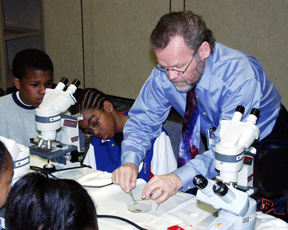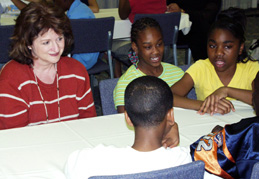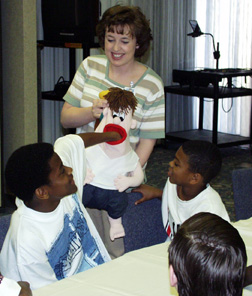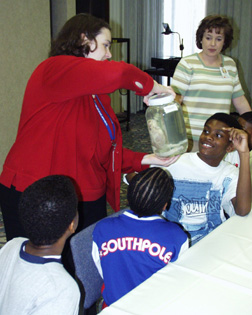 |
Dr. James Booth, right, shows Mike Garrett, left, and Cameron Caldwell how to prepare their microscope slides. |
The program, sponsored April 1 by the UNMC Youth Learning Center, was the first for Central Park students.
“The students were very enthusiastic,” said Lisa Jewell, director of the UNMC Youth Learning Center. “In fact, their teachers are looking forward to returning with another group of students next year.
“It was great to see the students so excited as they visited each work station. We are learning more and more about the importance of reaching out to elementary school students and getting them interested in learning about health sciences and health careers at an early age.”
 |
Jan Moore, left, listens to Saneetria Shannon, center, and Ashantae Lowery talk about their experiences with doctors. |
The work station subjects and facilitators included immunology with Courtney Olson, NHS staff medical technologist; all about red cells with Darlene Waters, clinical chemistry instructor for UNMC division of medical technology; all about organs with Christina Eastman and Peggy Mazzeo, coordinators in Donate Life Services; genetics and DNA with Susan Langdon, project manager, Health Care Education Partners, UNMC division of medical technology; microscope viewing with James Booth, Ph.D., associate professor, UNMC department of pathology/microbiology; and medical storytelling with Jan Moore, specialist, UNMC Office of Student Equity and Multicultural Affairs.
Medical storytelling
Moore told the students about a humorous experience she had in the doctor’s office when she was in the sixth grade. Then she asked the students to share experiences they or a family member had in the emergency room, hospital, clinic or dental office. She listened to the kids and then listed all the different kinds of health science jobs that were involved with those experiences – such as doctors, nurses, radiation technologists and dental hygienists.
 |
Christina Eastman holds Gus Guts as Chaunde Wright pulls out an organ. |
Eastman shared a number of samples of the most commonly transplanted organs. As an introduction to those organs, the students met Gus Guts, a Muppet-like doll containing replicas of kidneys, intestines, lungs, heart, kidney and liver that could be pulled out of his mouth. The doll helped the kids identify various transplanted organs and set the stage for a lesson on organ donation. The students also were shown samples of healthy organs and organs diseased from smoking and other ailments.
Hematology
Waters, who was in charge of the hematology station, asked students to describe what was in a drop of blood when they cut their finger. “I gave a brief summary of blood components – red and white blood cells, platelets and plasma,” she said. “Then, using red-colored clay, I showed the students how to sculpt normal red cells, and then abnormal red cells (a sickle cell, for example) from pictures I provided.”
Waters also had students play a blood cell matching game, in which they matched pictures of different types of blood cells. “At the end of our session, the students understand that the medical technologist is someone able to recognize all blood cells, normal and abnormal, to help the doctor diagnose disease,” she said.
 |
Peggy Mazzeo displayed a human heart for the students. |
Langdon explained DNA testing and how, for example, samples found at crime scenes can be used to rule out or confirm a person’s identity. She also discussed how important DNA was to identifying victims of the World Trade Center attack on Sept. 11, 2001. The kids also played a game in which they were given five sets of genes from alien families separated on a long journey from the “Planet Helix.” The students had to match the alien children with their alien parents. The game is part of an “Activity Box” developed by a group of medical technologists led by Waters, to teach grade school and middle school students about clinical laboratory science.
Microscopic world
Dr. Booth, one of UNMC’s 2003 Outstanding Teaching Award recipients, set up microscopes for the students to study water samples from Hanscom Lake. After explaining how to properly use the microscopes, the students made their own slides. “The activity with this age group is always an exciting experience for me,” Dr. Booth said. “For many of the students, it is the first time they have ever looked through a real microscope. It’s a lot of work to set it all up for 11 students and then do it again five more times, but it’s all worth it when I hear the ‘oohs’ and ‘aahs’ as they find little animals swimming around under their microscope. I always wonder if any of them will become a scientist and if I make a difference? It keeps me coming back.”